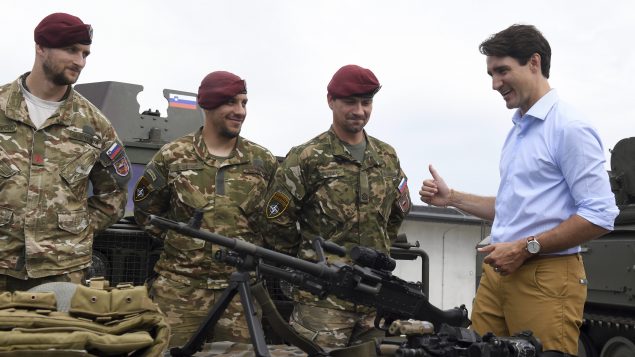Canada is increasing its contribution to NATO’s high readiness force by six additional fighter jets and a frigate, Prime Minister Justin Trudeau announced Wednesday at the NATO Leaders Meeting in London.
The announcement brings Canada’s total commitment to the NATO Readiness Initiative to 12 CF-18 fighter jets, an expeditionary air task force, a maritime patrol aircraft, three frigates, a submarine, a mechanized infantry battalion, a mobile hospital, and a platoon for chemical, biological, radiological and nuclear decontamination, officials at the Prime Minister’s Office said.
The initiative, dubbed the “Four Thirties” and approved by the alliance last year, aims to ensure that by 2020 NATO is able mobilize 30 land battalions, 30 air squadrons and 30 combat vessels within 30 days or less if faced with an emergency.
“For 70 years, NATO has been fundamental to Canada’s security and defence, and we remain committed to this alliance,” Trudeau said in a statement. “Today, Canada is leading NATO missions in Latvia, Iraq, and NATO maritime forces in the Mediterranean Sea and the Black Sea, and advancing the Women, Peace and Security agenda.”
Pressure to meet spending goals

U.S. President Donald Trump talks with Canada’s Prime Minister Justin Trudeau during a North Atlantic Treaty Organization Plenary Session at the NATO summit in Watford, Britain, Dec. 4, 2019. (Kevin Lamarque/REUTERS)
However, Canada and several other members of the alliance have faced pressure from Washington to make good on their promise to spend two per cent of their gross domestic product (GDP) on defence. Canada’s annual defence spending in 2019 is projected to be 1.31 per cent of its GDP, according to figures released by NATO.
Only nine members of the alliance meet the two-per-cent commitment.
Canada also falls short of another key NATO defence spending goal, which stipulates that alliance members commit to spending 20 per cent of their defence budget on equipment expenditures. Canada’s expenditures on new equipment in 2019 were expected to be 13.3 per cent of its total defence spending.
The position of successive Canadian governments both Liberal and Conservative has been that while Canada doesn’t meet the NATO spending benchmarks, it has proven with its deployments of combat troops in Afghanistan, in northern Iraq and Eastern Europe that it is always ready to contribute when asked by the allies.

Canadian Prime Minister Justin Trudeau speaks to Slovenian soldiers as he inspects the troops while visiting Adazi Military Base in Kadaga, Latvia, on Tuesday, July 10, 2018. (Roman Koksarov/AP Photo)
Canada commands a multinational NATO battle group in Latvia, part of the alliance’s beefed up presence in neighbouring Estonia, Lithuania and Poland set up following Russia’s annexation of Crimea in 2014 and its meddling in eastern Ukraine.
In July 2018, Trudeau announced that Canada is extending its NATO commitment in Latvia by another four years to March 2023 and will boost the number of troops in the country to 540 from 455 soldiers it had stationed in the tiny Baltic previously.
Trudeau also joined the 28 other members of NATO in endorsing the London Declaration, issued at the end of the sometimes contentious summit that saw sparks flying between U.S. President Donald Trump and his French counterpart, Emmanuel Macron.
The two disagreed over Turkey’s incursion into northern Syria and the French president’s description of NATO as being “brain dead.”
Trump also called Trudeau “two-faced” Wednesday after the Canadian prime minister was caught on camera during a reception at the Buckingham Palace, poking fun of U.S. president’s knack to befuddle aids with impromptu press conferences.







For reasons beyond our control, and for an undetermined period of time, our comment section is now closed. However, our social networks remain open to your contributions.